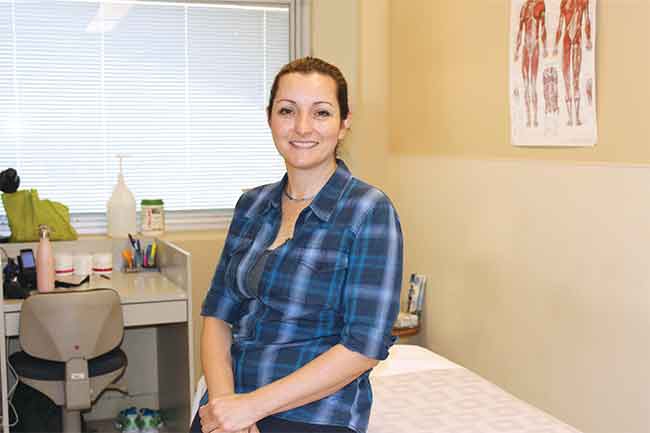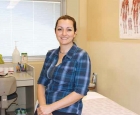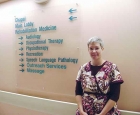
Features
Education
Leadership
Hospital practice
Massaging patients on a gurney with tubes running across the bed and around them might not seem like the ideal treatment set-up, but massage therapists who work in hospitals say it is one of the best clinical experiences a therapist can ever have.
October 19, 2015 By Mari-Len De
 Annette Broderick-Colombo wanted to work in a hospital since she was a massage therapy student at Sutherland Chan. Massaging patients on a gurney with tubes running across the bed and around them might not seem like the ideal treatment set-up
Annette Broderick-Colombo wanted to work in a hospital since she was a massage therapy student at Sutherland Chan. Massaging patients on a gurney with tubes running across the bed and around them might not seem like the ideal treatment set-upIt was certainly true for Trish Dryden back in the early 80s when she worked as massage therapist at the pain clinic in Toronto’s Sunnybrook Hospital. “I can’t think of any single, clinical education experience where I learned more than I learned in seeing so many patients, with so many diverse backgrounds.”
Back then, integrating massage therapy into hospital-based patient care was a novel idea, and Dryden was one of the first massage therapists in Canada to ever work in a hospital setting. Her interest in chronic pain issues motivated her to seek out the opportunity to work with hospital patients after graduating from Sutherland Chan.
“I had heard about an excellent pain clinic at Sunnybrook Hospital in Toronto, and went and met with the two anesthetists who were heads of the pain clinic,” Dryden recalls. She proposed the idea of integrating massage therapy into the pain clinic, which had just then introduced acupuncture in the setting. The doctors decided to try the idea, and Dryden spent the next three years working as a massage therapist at Sunnybrook.
Knowing who to talk to and when is important for therapists who are looking to work in a hospital setting. For Manuela Brodalla, a RMT in Edmonton, Alta., it took all that and being at the right place at the right time.
Brodalla is in practice for eight years and the last six years has been spent working in the massage therapy clinic at Grey Nuns Community Hospital in Edmonton. She has always been interested in the clinical aspect of massage and when the opportunity to work at a hospital unexpectedly presented itself, she took it.
“I had aging parents and they required some outreach services. I discovered that the hospital had therapeutic classes for the elderly, and that is when I found out they actually had massage here,” Brodalla recalls. At the time, she overheard the staff talking about needing another massage therapist. She asked her mother to introduce her to the hiring manager and the rest is history.
The clinic is located in the hospital’s rehabilitation medicine department, where Brodalla sees a variety of clinical cases – post-operative, geriatric, palliative, stroke and cancer patients, to name a few.
She also provides massage to patients in the intensive care unit. On occasion, Brodella has been required to wear full personal protective equipment, such as a respirator mask and gloves, which can pose certain challenges to a massage therapy session. These are minor inconveniences a therapist working in acute care setting may be faced with, but they are still expected to provide the best care for the patient.
“It’s just a different spectrum of care. We’re not only working around the machinery – the heart machines, the oxygen – working around the bed can be quite challenging for the therapists as well. But I find it more rewarding when you see that person have at least five to 10 minutes of just the pain subsiding so they can be happy for just that brief period.”
Working alongside other health-care professionals and researching the various health conditions that come her way also provide great learning opportunities for Brodalla. The hospital library allows her to look up medical journals pertaining to the specific case she is dealing with. She would then go through the patient file with the head nurse to discuss the patient’s history, the current medical condition and explore treatment protocols.
Toronto RMT Annette Broderick-Colombo entered massage therapy school with the intention to work in a hospital setting. Like Brodalla and Dryden, her keen interest in chronic pain and rehab was her motivation. Soon after graduating from Sutherland Chan, Broderick-Colombo found part-time work at Mt. Sinai Hospital’s Rehab and Well-being Clinic in Toronto. She sees patients at the hospital three days a week. The rest of the time she is in private practice.
In a typical day, she would see an average of seven patients. Some are in-patients, some outpatients, and many are hospital staff members – doctors, nurses and other hospital employees – many of whom become advocates of massage therapy after experiencing the treatment.
“It could be a doctor who has used our service before, it could be a lot of the nurses I’ve worked on… so when patients are complaining about back pain the staff will say, ‘we have a massage therapist on staff.’ The person will make the call, the clinic will fit them in the schedule,” Broderick-Colombo says.
In some cases, the family members will seek out massage therapy for their sick loved one, particularly for cancer patients or those in palliative care. Sometimes, the family members themselves would require massage, which provides them some level of comfort and helps alleviate some of the stresses of caring for their sick loved one.
Uptake
Massage therapy in Canadian hospitals has existed for more than three decades – certainly as far back as when Dryden started working at Sunnybrook – but progress had been slow.
A survey of 305 Canadian urban hospitals, conducted by massage therapist and researcher Ania Kania-Richmond, revealed only 69 hospitals or 22 per cent are providing massage therapy services. Upon further inquiry, the study showed only 16 hospitals – located across four provinces: Ontario, Alberta, Quebec and Nova Scotia – have integrated massage services that are provided by licensed massage therapists. That’s only five per cent of all the urban hospitals initially surveyed in the study.
“One of the things that came out of the survey is that massage therapy is not necessarily new in hospital settings,” says Kania-Richmond, former executive director of In-Cam Research Network, a Canadian complementary, alternative and integrative medicine research organization.
The type of hospitals where massage therapy is integrated also varies from large multicomplex hospitals to the very small, local or specialty hospitals, says Kania-Richmond, who is also a registered massage therapist trained in Ontario.
Although some are hospital employees, most massage therapists who work in hospitals are independent contractors, the research finds. On average, a hospital would have about three therapists working on site. In one of the hospitals surveyed, there were nine massage therapists working there but they were all volunteers.
Kania-Richmond’s research also provided insights on how massage therapy service is delivered in hospitals. “What emerged was that there are three different ways that massage therapists are organized in hospitals: closed, open and independent.”
In a closed set-up, massage therapy is integrated in one specific unit or department and only patients from that unit are able to access the service. In an open model, massage therapy is still part of a unit but patients in other units have access to massage therapy treatment if needed. In an independent model, massage therapy is a standalone clinic within the hospital, not part of any department or unit, and is open to any patient, staff or the public.
In her study, Kania-Richmond also looked at the role massage therapists play in hospital patient care.
“What became apparent is that the professional role of a massage therapist encompasses various components,” she notes. Providing care and hands-on treatment as well as being responsible for the assessment and identifying plan of treatment from a massage perspective are certainly a big part of their role. There are other auxiliary roles massage therapists take on when working in hospital.
Some of the roles that emerge from the study include: team member, educator, promoter of massage therapy, and researcher.
“This means if you are going to be a therapist working in a hospital setting – and I will extend this to say in any health-care setting – you need to be prepared to wear all these different hats because that’s what it’s going to take establishing yourself as a professional in that particular setting working with patients,” Kania-Richmond points out.
Career prospects
Because of the many hats a massage therapist may be expected to wear in a hospital, a strong educational foundation is essential. Currently the associate vice-president of research and corporate planning at Centennial College, Dryden believes research and education play an important part in increasing massage therapy participation in hospital-based care. “The education really has to be there to support it.”
Broderick-Colombo credits her good education for arming her with the necessary skills and knowledge not only to perform well in a hospital environment but also to effectively deal with the emotional aspect of the job.
“Even in regular clinics, there will be times when people will just break down and cry, because touching them stirs the emotion or they just needed someone to talk to,” she says. “Part of our curriculum is called therapeutic relations and it’s excellent in teaching you how to deal with the emotional side of massage and transference.”
Brodalla, the massage therapist from Edmonton, is also doing what she can to increase uptake for massage therapy in hospitals. For the last six years, she had been trying to get one of Grey Nuns’ sister hospitals to incorporate massage therapy. She said the number one challenge for hospital administrators is space.
“Trying to find a location or even just a spare room anywhere in the hospital is tough… because they would rather just fill that up with beds or a surgical theatre or whatever they may need,” says Brodalla, who also sits on the advisory committee for the massage therapy program at McEwan University in Edmonton.
Dryden agrees increasing attention to massage therapy among hospital administrators and stakeholders will certainly help in improving career prospects for massage therapists in hospitals and other health-care settings. Research advocacy will be a significant part of that agenda, she says.
“We need to keep moving forward and keep the research going that shows the efficacy and the value, the economic impact of doing this,” says Dryden.
Although massage therapy research is relatively in its infancy, there is increasing body of knowledge about the health-care benefits of massage therapy that can certainly help the cause of raising the profile of the profession. It’s a matter of getting this information to hospital administrators and other health-care stakeholders – and that needs to come from the profession itself.
“Professional associations across the country should be getting themselves either on hospital boards or when hospital administrators come together for professional development. We should be presenting the evidence and talking about it,” Dryden says.
One study that has come out recently points to the cost-effectiveness of massage therapy in improving patient outcomes. The study titled, “Analysis of provider specialties in the treatment of patients with clinically diagnosed back and joint problems,” found massage therapy was the most cost-effective among non-doctor practitioners in improving quality of life measures.
At least one professional association is actively pushing the hospital hype. The Massage Therapist Association of Saskatchewan (MTAS) has been promoting awareness of the important role of RMTs in hospital patient care. In fact, it is a big focus in its Third Annual Interdisciplinary Research Symposium to be held in April in Regina, Sask., where Kania-Richmond will be one of the speakers.
In an e-mail sent to Massage Therapy Canada Magazine, MTAS echoes Dryden’s perspective.
“Spreading the word through the sharing of research about massage therapy in hospital is the kind of initiative that can increase opportunities for Saskatchewan RMTs to work in hospital settings. For example, members interested in working in this setting will become more aware of the possibilities and have published literature in hand to open a conversation with primary care providers and hospital administrators. MTAS is proud to provide this ‘state of the art’ information for our members.”
Mari-len De Guzman is the editor of Massage Therapy Canada magazine. She has been a journalist for more than 15 years. You may contact her at mdeguzman@annexweb.com.
Print this page

